- You are here:
- Home »
- Goalkeeping
Category Archives for Goalkeeping
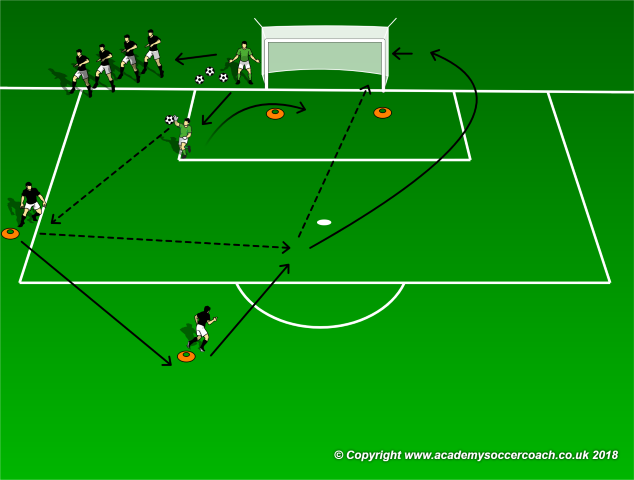
Brazilian Street Games to Develop Your GKs
By Danny Carvalho,
The following games exist for a long time. Back on the 90s/2000s you could see in any place you would go in Brasil where there was a goal or anything alike, a whole bunch of kids (including myself) and teens playing these games for fun. Little did we know how good these games were for technical and tactical improvement. So let’s jump right in!
These games cover topics such as shot stopping, handling, distribution from hands and from feet, coming out of the line and long kicks.
Game 1 – Goalie wars
That’s no big novelty for most coaches. After spending a few seasons working in the U.S.A I got to witness that this was no Brazilian exclusivity.
Usually played in a 1v1, when one player is shooting the other one is protecting their net. Adapt the size of the pitch and nets according to your players ability, height and strength.
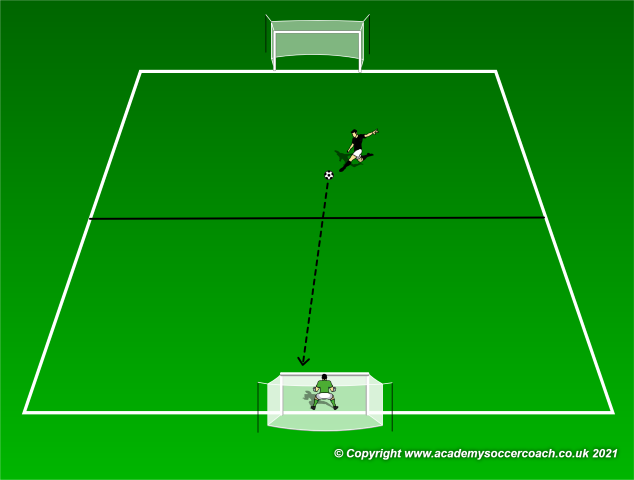
Game 2 – Top goalscorer
Played on a 2v2, this one can be hard for young and less skilled and/or strong players. Just like game 1, the size of the pitch must be adapted to the group according to their specificities.
It consists on each double having a GK and a striker on the opposite half of the field. When the GK has the ball they must kick it or throw it to their striker in order to score on the opposite goal. The challenge here is to pass the ball without it being intercepted by the opponent’s striker. If the ball goes clear to the striker, they must score with two touches max and from out of the box. If the ball deflects on the opponents striker they get an extra touch.
If the striker scores, they must swap positions (GK becomes striker, striker becomes GK).
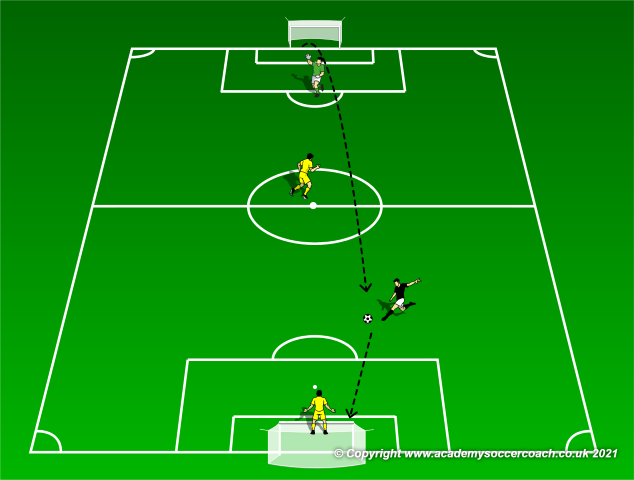
Game 3 – The Rebatida
This one has multiple versions across the country with small differences on the rules. I’ll use the one I remember and use the most with my players.
Also played in a 2v2, this one starts with the defending team having two goalkeepers and the attacking team starts with one player having a free kick from a set spot and the 2nd player positioned on the goal line right next to the goal, ready for a possible rebound. If there is a rebound or a corner kick, one of the GKs becomes a defender and a 2v1+GK starts right away.
Each attacker has 3 free kicks. Play is over if a goal is scored or GKs hold the ball. One team takes all 6 free kicks first and then teams swap roles.
Pointing rules:
Score from free kick = 1 point
Score from a GK rebound = 2 points
Score from a corner kick = 3 points
Ball hits post + Score = 4 points
Ball hits crossbar + Score = 5 points
Ball hits crossbar corner + Score = 10 points
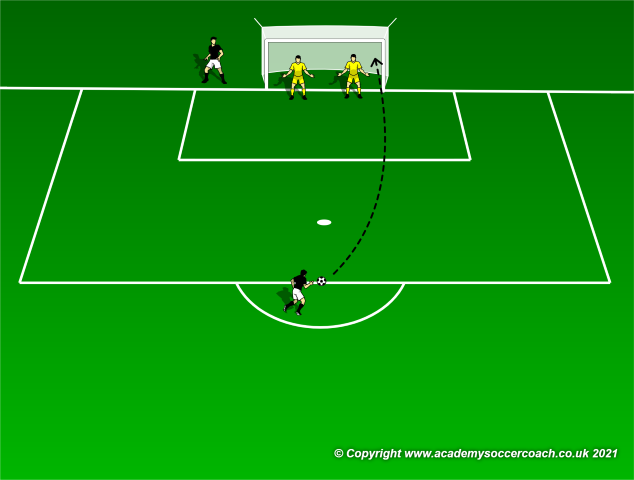
Game 4 – Three in, three out
On this one you can have as many players as you would like and one in goal as a GK. I recommend no more than five players total involved to avoid boredom and players standing unmotivated.
Set a GK box of an adequate size according to your group. Have one GK in goal and all the other players are going to be attackers spread out on the outside of this box. One attacker must lift the ball so a second attacker scores from a volley or a header. All shots must be taken from out of this GK box.
If attackers score three goals first, the GK gets a punishment. If the attackers finish the ball wide three times first, the last one to finish is the next GK. If the GK saves the ball and holds it, the attacker who just finished gets punished and is the next GK.
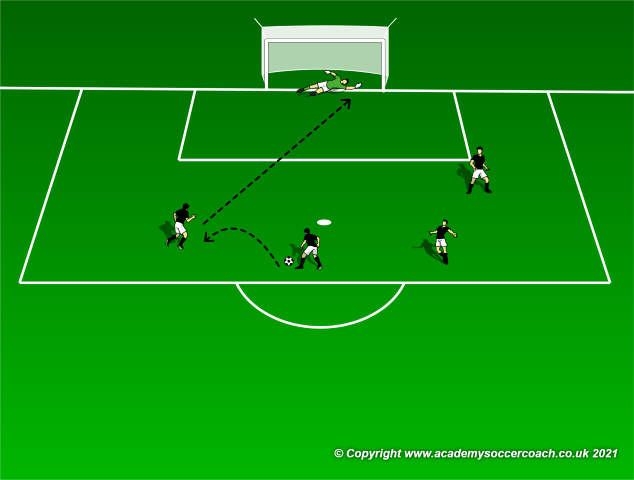
By Danny Carvalho, DOC at Corinthians Campinas Youth Club, Brasil

Explosive Goalkeeping Like Keylor Navas
By Danny Carvalho,
I truly madly deeply admire Keylor Navas’ capacity to reach for balls apparently too far to stop. He is amazingly explosive between the bars and underrated in my humble opinion. This practice was designed to have your goalies make miracles like a UEFA Champions League champion!
Warm Up
Have two cones of different colors aligned with the post and parallel to the penalty kick spot. Right next to the goal posts, have these colors diagonally apart as shown in the diagram below. The coach runs to one of the colors as the cue. The GK reacts as fast as possible running to the correspondent post and then stops the shot on the opposite side.
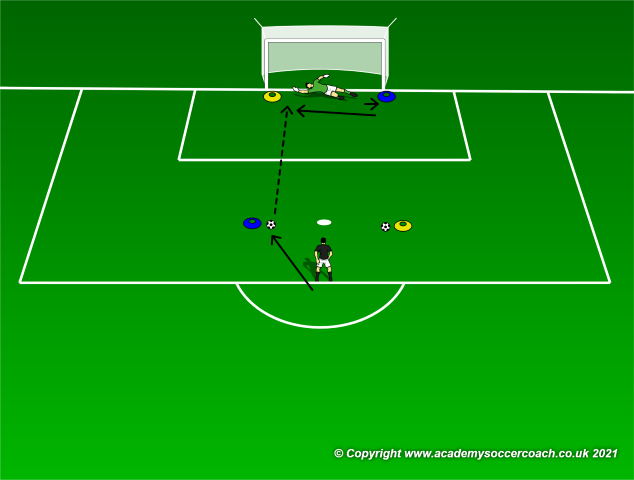
Activity 1
The coach is going to take six shots in a row, aiming for opposite sides of the goal. The GK must stop it!
This one is inspired by a practice I’ve seen the legend Dida on it. Click here to check it out.
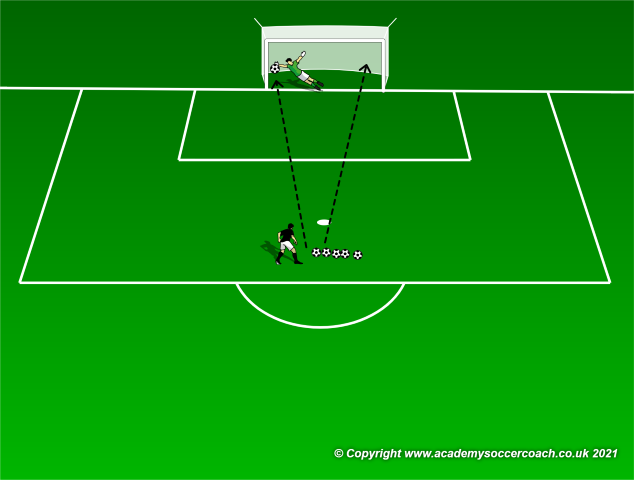
Activity 2
This next one is pure insanity for the GK. I like to call it “I dare you to stop 3”!
Have two goalkeepers positioned each at opposed corners of the six yards. Have a third player at a little bit out of the eighteen yards. All three players with a ball. On the coach’s command, #1 takes a shot shortly followed by #2 and then #3 comes dribbling for a 1v1 against the GK.
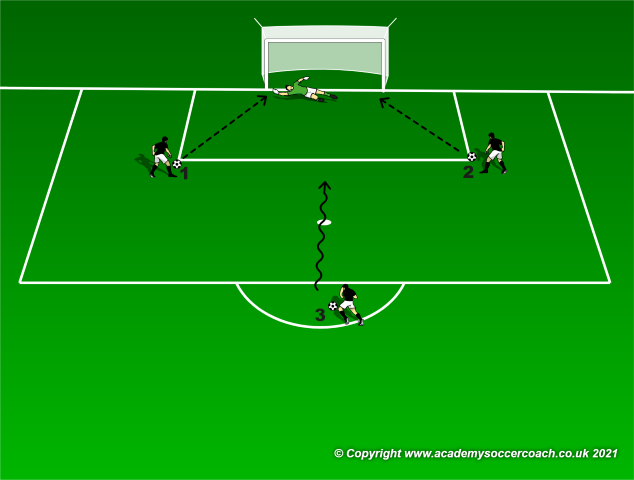
Activity 3
I can’t help but end this practice with this fun and challenging drill called “Soccer machine gun”.
Have as many GKs as possible positioned to take shots. Include yourself! A bunch of balls aligned at the edge of the box. On command, the whole crew starts taking shots in sequence. GK must stop as many as possible.
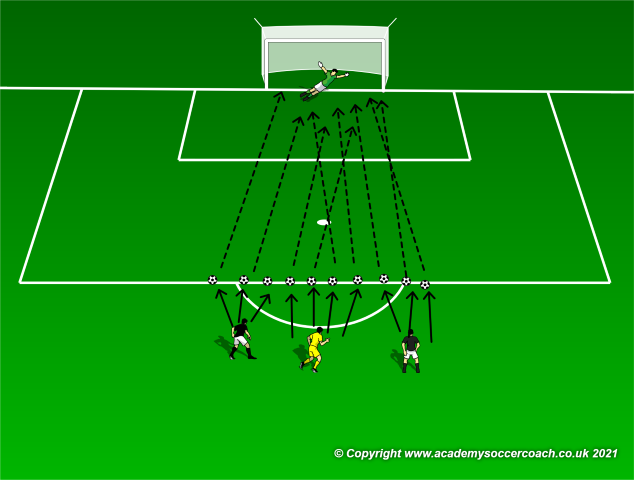
By Danny Carvalho, DOC at Corinthians Campinas Youth Club, Brasil
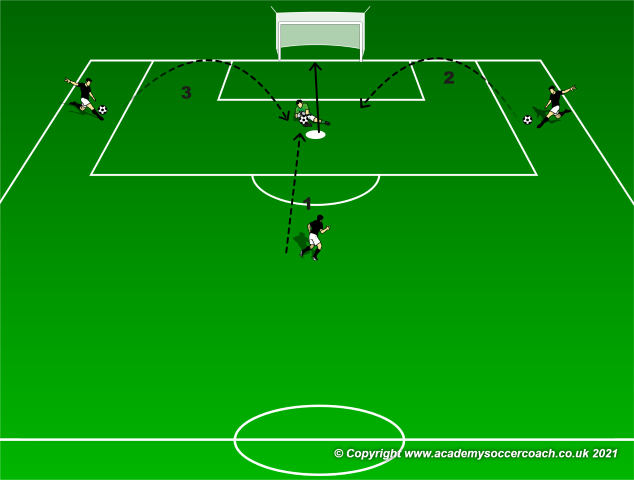
Stop Crosses Like Cortouis
By Danny Carvalho,
This very important skill is often neglected on goalkeeping specific training which cannot be accepted by a head coach who wants to achieve great accomplishments in their season. So here goes a simple and basic practice on stopping crosses.
Warm Up
Goalkeepers working in pairs. The goal is just to get the body fired up for the session. Have them throw high balls and kicks to get working on the handling the ball high up and jumping to reach for the ball.
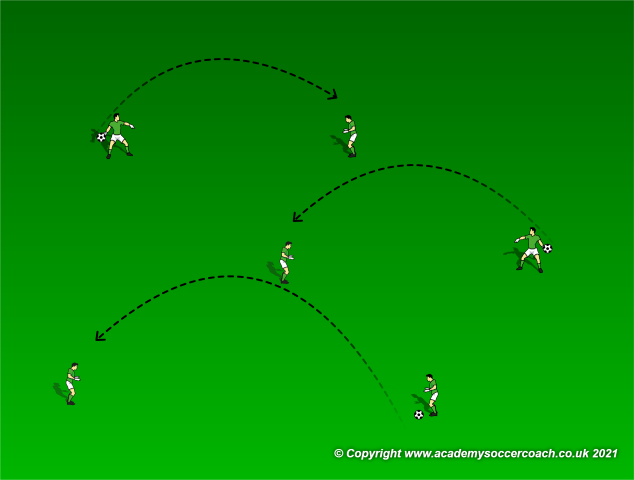
Activity 1
GK in position. Stop one shot first. Run backwards to goal line. Come out to stop a cross from the right side. Throw it back to the person who crossed it. Get back on the line and stop another shot. Run backwards again to goal line to then come out to stop a cross from the left side.

Activity 2
In this next activity use dummies if you have access to them. Otherwise, have the other GKs work as shadows in the box as shown in the diagram below. Each GK stops a cross coming from a corner kick from each side.
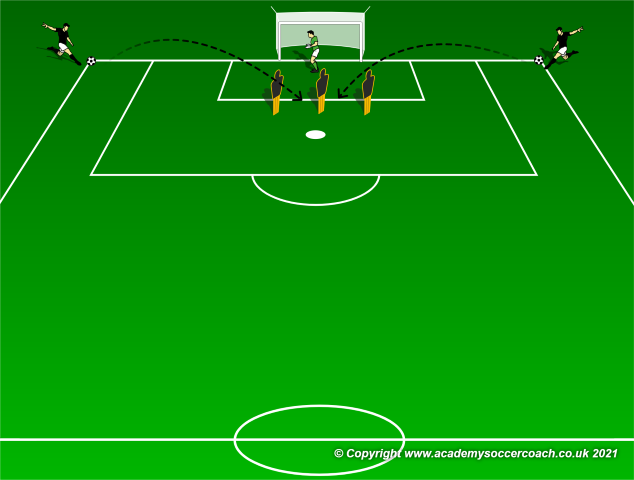
Activity 3
To end practice in great fashion, have players in the box actually trying to score as the goalkeeper tries to stop the crosses from reaching the headers.
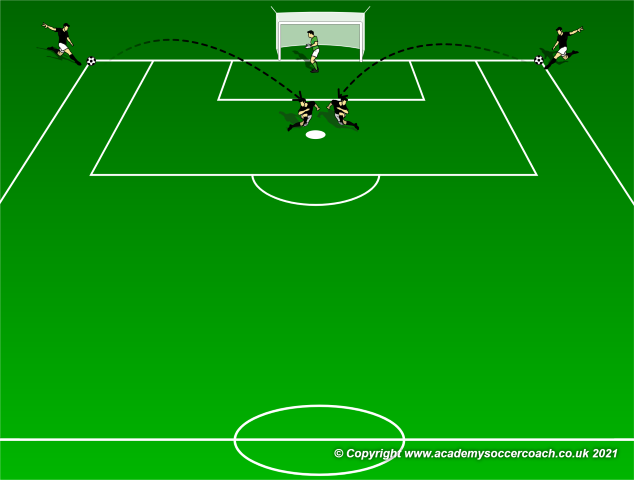
By Danny Carvalho, DOC at Corinthians Campinas Youth Club, Brasil

Come Off the Line Goalkeeper
By Danny Carvalho,
This ability is a game changer. It separates the average GK from the outstanding GKs! Not only the ability but the decision making, the timing, the courage, the urgency and the acceleration.
Warm up
Have one GK in the six yard and another facing them at about 5 yards outside the box. Passing to each other back and forth until the player outside the box decides to dribble towards the goal. That’s the cue to the GK to come out and stop them. Because it’s a warm up, the player in the attacking role will let the GK win the play.
Progression: instead of dribble the ball, the attacker takes a big touch to a direction to have the GK run for a challenge.
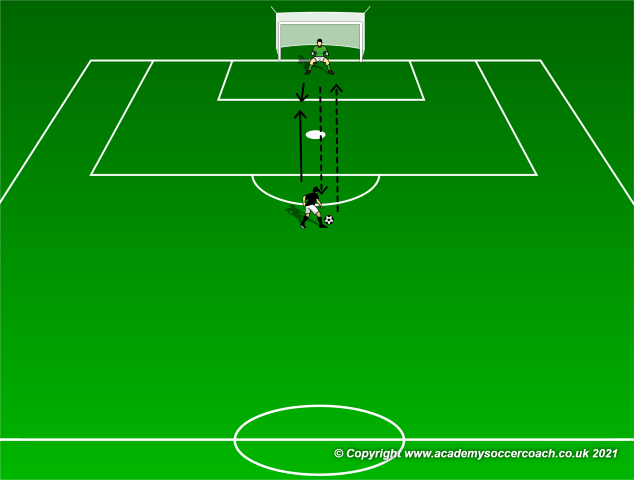
Activity 1
In this next situation, the GK is going to perform the Sweeper Keeper role like Manuel Neuer did in the famous clash Germany x Algeria in the 2014 World Cup playoffs on the extra time.
Have three players positioned as wingers and a striker at about 30 to 40 yards from the goal. Coach on the ball, GK on the goal line. Coach is going to send a long ball on the space behind the defense towards one of the attackers. GK must be first to the ball.
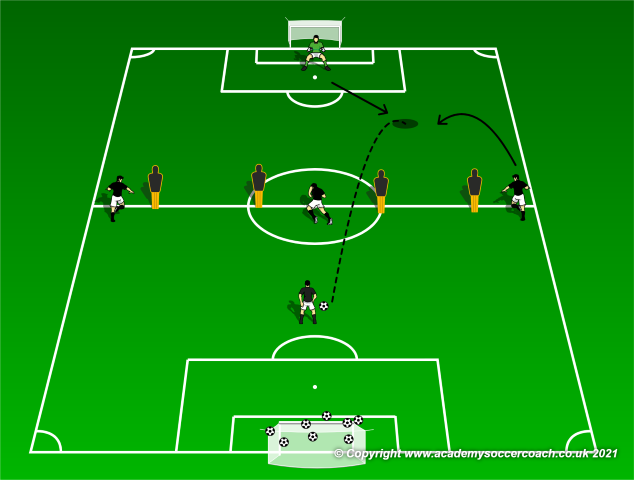
Activity 2
GK on goal, two players coming one at a time from diagonal angles to work on 1v1s to come out the line. The GK starts facing the net. On the coach’s whistle, GK turns, and the attacker will already be running with the ball. This will make the GKs work on their speed of reaction.
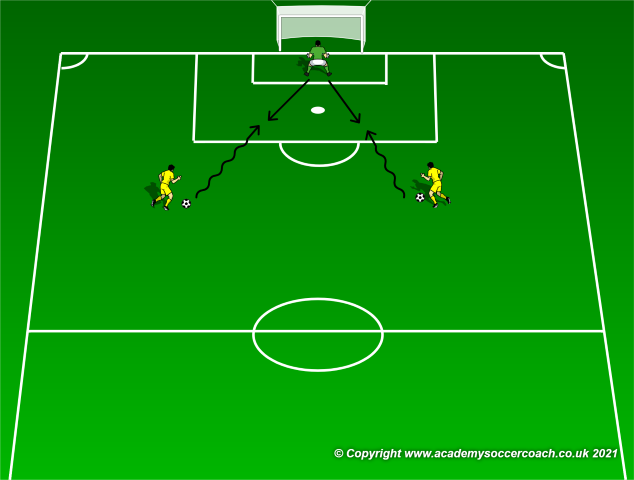
Activity 3
To end with, we are going to work on the GK + last defender dynamic on a 2v1. On this one, the defender will be advised to cut the pass and force the attacker with the ball to challenge the GK. That’s when the GK is going to work on their coming out of the line ability.
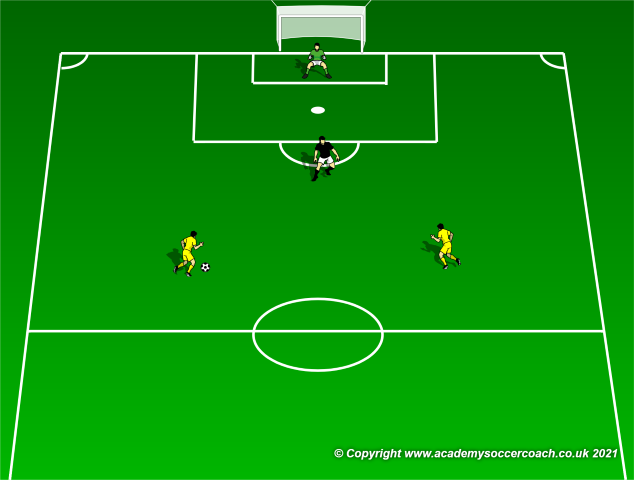
By Danny Carvalho, DOC at Corinthians Campinas Youth Club, Brasil

Goalkeeper Distribution Following Cruyffs Principle
By Danny Carvalho,
The one and only Johann Cruyff once said a phrase that is forever immortalized in soccer for the ones who appreciate attacking and possession-based soccer. It was something like: “In my teams, the goalie is the first attacker, and the striker the first defender.”
As I’m a big fan of this philosophy, I like to often times on the GKs specific practice work on distribution and playing from the back.
This a session usable to every age group.
Warm Up
GKs are going to be working in pairs. Start five to ten steps apart depending on the level and age group.
1- Two hands chest throw (10 times)
2- One-handed side shoulder throw (10 times each arm)
3- One-handed over shoulder throw (10 times each arm)
4- Short passing back and forth (10 times each foot)
5- Long passing back and forth (6 times each foot)
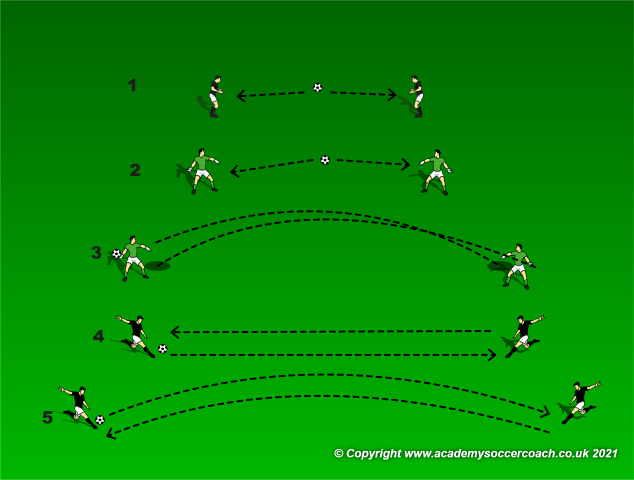
Activity 1
GKs taking turns on goal, another two GKs open wide. One of the open wide GKs takes a shot on goal. The GKs on the spot must save it and then throw it to the opposite open wide GK. The principle here is to stop the shot first and then as soon as possible distribute on opposing side of the play, thinking about the game situation where when the play comes from one side, this is probably the most crowded place on the field in the moment. By throwing it to the other side, we are thinking about starting quickly a counterattack on the open side.
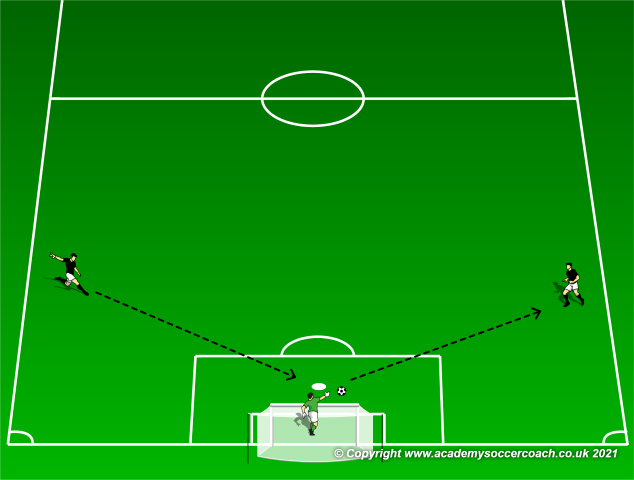
Activity 2
In this activity we are going to emphasize the building from the back moment. Now we will have two players on the side of the box, one on each side. The GK is now going to work on pass to one side, move to the bottom line to support the player, receive it back, turn and switch the play and so on for a set time. On the coaches’ whistle, sharp pass to one of the two mini goals positioned in a diagonal angle as the midfielders to progress up the field.
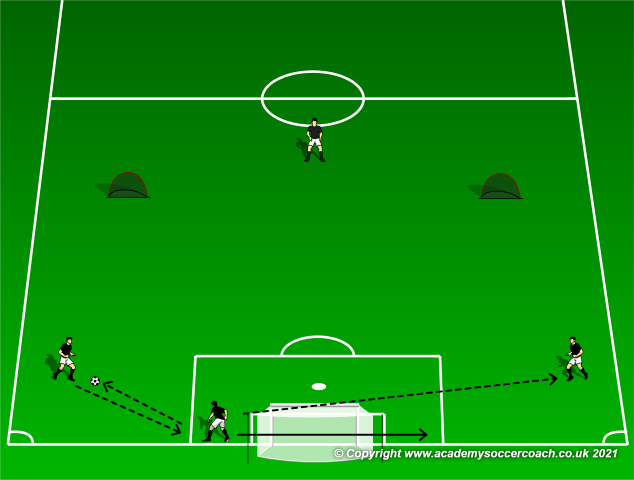
Activity 3
In this last activity we are going to play a possession game focused on the GK getting used to play with their feet and play under pressure in the box. The numbers of this confrontation will depend on the GKs age group and ability as well as the quantity of GKs available at practice. If they are beginners, maybe a 5 v 1 is the best option. As the coach, jump in to help if needed. If they are medium to advanced level, 4v1, 4v2 or 5v2.
Have each GK play from 1min to 2mins in their original goalie position and then rotate. Obviously, if the player(s) in the middle wins the ball, try to score and the GK tries to stop them from scoring.
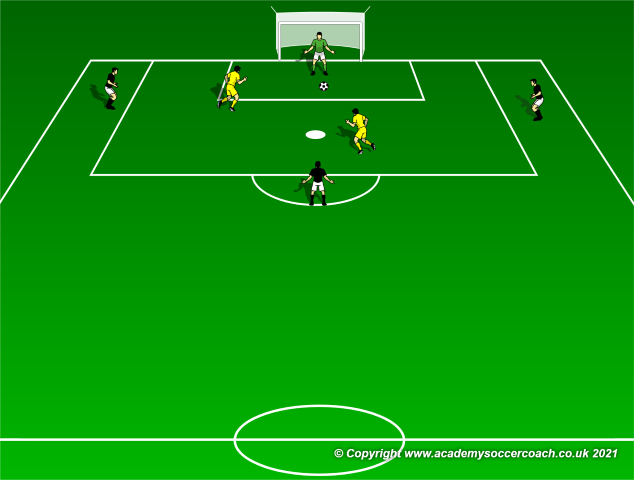
By Danny Carvalho, DOC at Corinthians Campinas Youth Club, Brasil
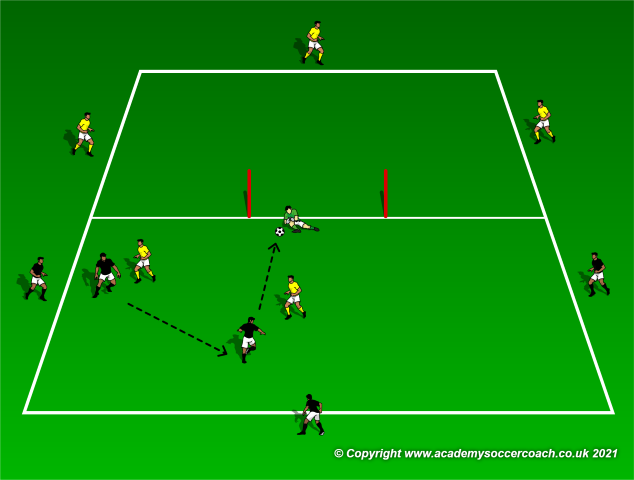
Goalkeeping Specific Agility and Reactivity
By Philip Cauchi –
The follow three practices target the development or maintenance of agility and reactivity that are specific to the position and role of a goalkeeper. Through these practices we also develop quick footwork, quickly getting into position with reference to the position of the ball with the goal, establishing the correct body profile (stance), and when and how to dive correctly to make a save.
Practice 1: Two goal quick reaction save
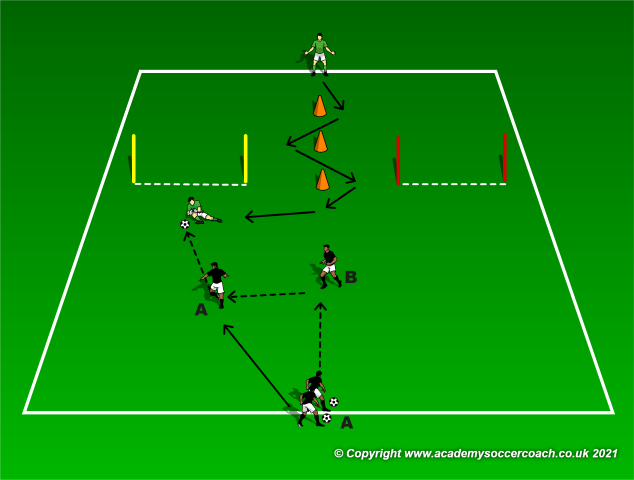
Description: The goalkeeper side steps through the line of cones prior to get into position to either move towards his right or his left to save player A’s shot after the latter wall-passes with player B to finish on either the yellow or red goal. The goalkeeper must quickly recognise where player B lays off the ball to player A so to quickly move into position in the correct goal to save the shot. Player B should be positioned 12 to 15 yards in front and in between the two goals. To increase the difficulty of the practice, player A will be positioned closer to player B thus reducing the time for the goalkeeper to quickly move in the correct direction to make the save.
Practice 2: The central goal game

Description: The practice area measures 30 yards by 20 yards and which is divided into two zones with a central goal positioned on the mid-line. A goalkeeper guards the central goal. Each team has its own half from where they are allowed to score. A player for each team is positioned at each side in their own half. Two players from each team roam inside the area. Therefore in their own half, teams will have a numerical advantage of 5v2. The players on the perimeter are also allowed to score. If a goal is scored or won by the defensive team and played into the opposite side, the goalkeeper must quickly adjust his position to protect the goal from a different angle inside the other half of the practice area. When the goalkeeper makes a save, he serves the ball to any other player of the opposite team in the opposite zone.
Practice 3: Adjusting quickly to close down the shooting angle
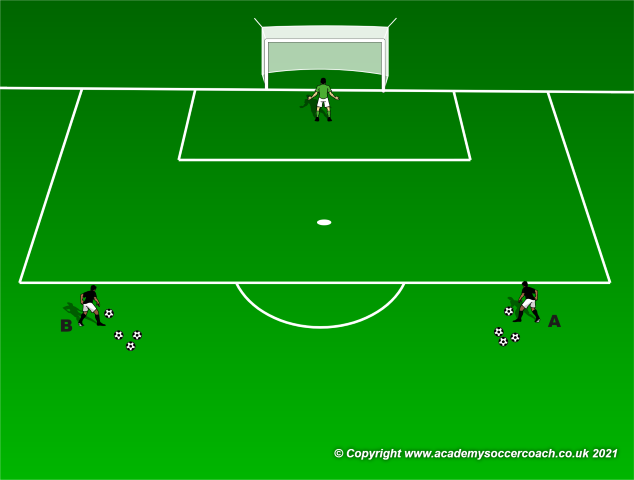
Description: Two servers A and B are positioned at different angles outside the penalty area. The goalkeeper faces the opposite direction (towards his own goal). When the coach calls out the name, or letter, or number representing the server, the goalkeeper must quickly turn to save the shot from the respective server. To increase the level of difficulty and make the practice more complex, when the coach calls a server it will be the opposite server who takes the shot on goal. To make the practice even more challenging we can increase the number of servers and have them dribble their ball randomly, thus continuously changing their angle in respective to the goal.
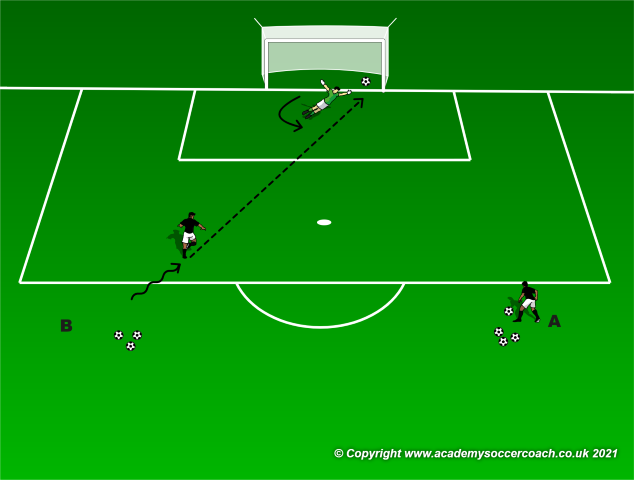
The first step should always be simple for both the goalkeeper and the servers to understand. From here we can then progress the practice further and according to the developmental requirements of the goalkeeper.
By Philip Cauchi
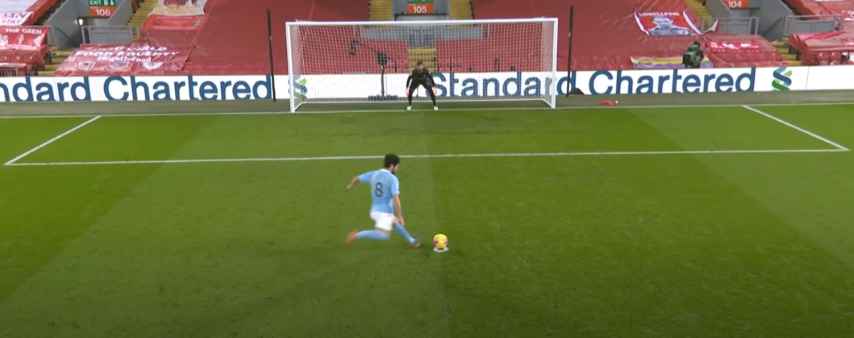
Facing Penalty Kicks
By Philip Cauchi –
Facing penalty kicks are very challenging situations for any goalkeeper. Goalkeepers haven’t got any defenders between them and the ball within a distance of twelve yards. The defenders must also be positioned at least ten yards away from the ball and outside the penalty area until the shot is taken. Furthermore, goalkeepers must remain with at least one foot touching the goal line until the ball is kicked. This makes it even more complicated for them while providing an extra advantage for the kicker.
However, certain key performance points exist in that they help goalkeepers increase their success rates at saving penalty kicks. We can start by carrying out an analysis of the penalty taker that the goalkeeper will possibly face in the upcoming match. In modern times this can be easily done with the use of highly accurate statistics and match analysis software, where both the goalkeepers and the goalkeepers’ coach can analyse together and into great detail what the favourite kicking foot of the possible penalty takers is, the angle they make with the ball before the run-up, and where they usually aim their shots. Right-sided dominant kickers usually aim their shots towards the right side of the goalkeeper, while left-sided kickers usually aim towards the left side of the goalkeeper. However, this shouldn’t be taken as a rule of thumb but as a probability.
Taking a quick glance at the penalty takers’ eye movement prior to taking their shot might help the goalkeeper in identifying to which part of the goal the kicker aims his shot. One mistake that goalkeepers should not do is to initiate the dive just a few moments before the kick is taken. This is a very typical mistake of goalkeepers who focus solemnly on the swing of the kicking leg. Should this be the case the kicker will probably change the trajectory of the shot at the last minute. This is a trick that some penalty takers use and which goalkeepers should be aware of. The below are the key points that goalkeepers should focus on when facing a penalty kick.
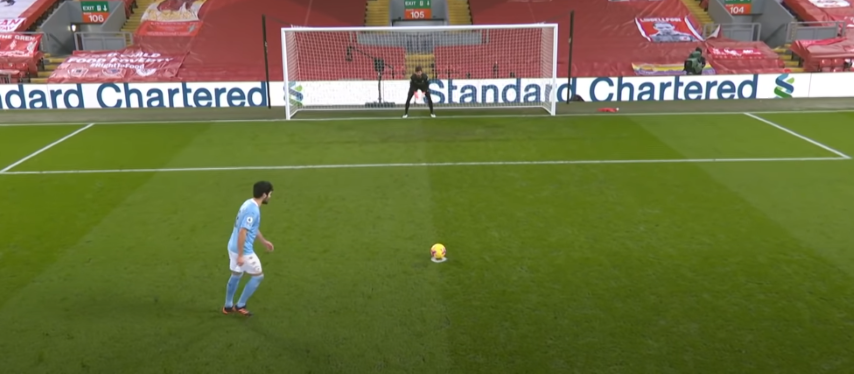
The goalkeeper should be positioned at the centre of the goal in line with the ball. His eyes focused on the ball, feet shoulder-width apart, arms in front of the body and with a low-centre of gravity body stance. A run started from the kicker’s left side typically indicates that the shot will be aimed towards the goalkeeper’s right.

The goalkeeper should not commit himself before the penalty taker kicks the ball. He should however take a note of the taker’s trajectory to the ball and the direction that the support foot is planted.
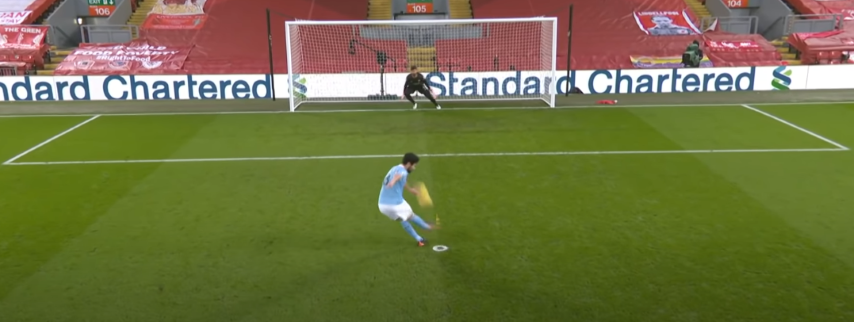
The direction the support foot is planted together with other important information such as that the taker is right footed, that he usually aims his penalties to the right side of the goalkeeper, the direction the hips are facing, and his last glance to where he is aiming the shoot, all provide the goalkeeper with relevant information to make the required decision.
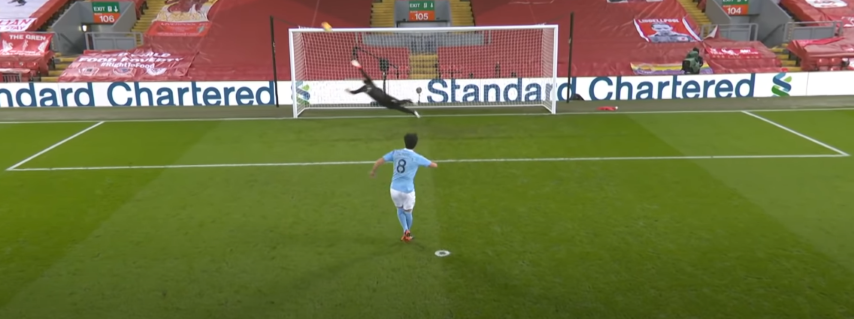
The goalkeeper steps towards the trajectory of the ball by first stepping diagonally forward and pushing off the outside leg. His eyes should follow the ball and arms extended towards the ball to increase his reaching ability.
By Philip Cauchi
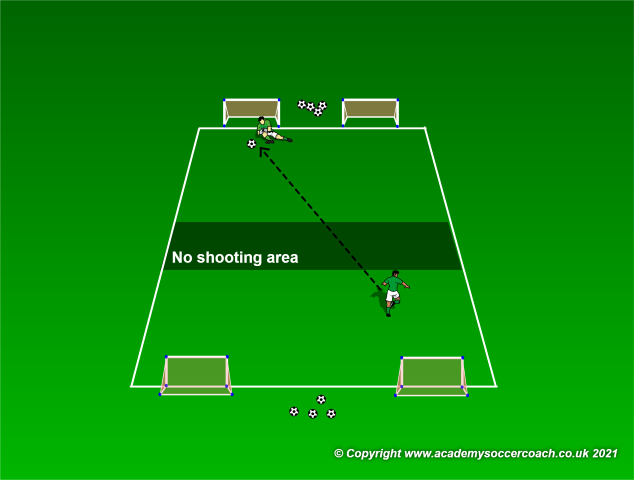
Coaching Basic Catching Skills
By Philip Cauchi –
The below are games that develop the basic skill of catching which is a pre-requirement for the development of goalkeepers. These games target the foundation phase between eight and twelve years of age. However, they could also be used with younger ages if the children demonstrate to have the ability to take on these challenges.
Game 1: Throw and catch.
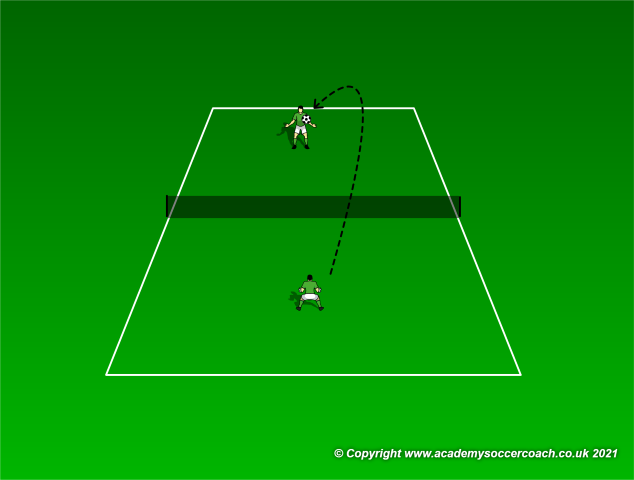
Description: The goalkeepers throw the ball over the net for the other goalkeeper to catch. The ball must not touch the ground. If the ball makes contact with the ground the goalkeeper who threw the ball earns a point.
Variation: The ball may be allowed to bounce once before it is caught.
Key outcomes:
1. Ready stance.
2. Positioning – centrally where the goalkeeper can quickly move to catch the ball.
3. W shape of the hands to catch the ball.
Game 2: Throw the ball to score.
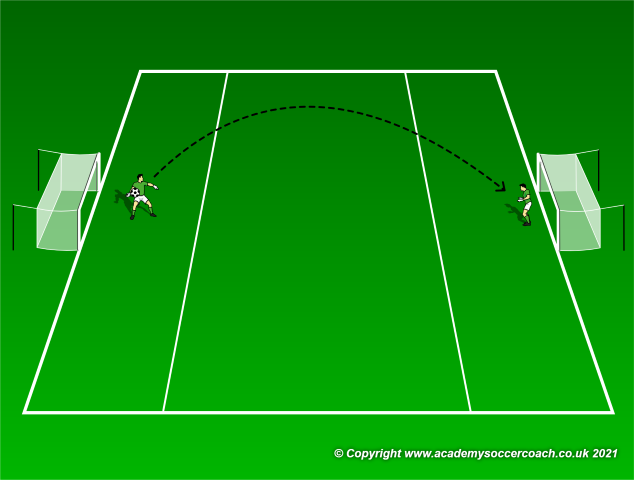
Description: In this game the goalkeepers are positioned approximately ten to fifteen yards apart, depending on their physical maturation. Both of them must defend a goal and aim to score in the opposite. They score by throwing the ball from inside their assigned area (in the above image it is behind the white continuous lines).
Variation: The goalkeepers may kick the ball instead of throwing it.
Key outcomes:
1. Ready stance.
2. Positioning in goal.
3. Quick footwork to get to the ball and make the save.
4. Shape of the hands to catch the ball.
Game 3: 1v1 goalkeeper battle on four small goals.

Description: Each goalkeeper defends two mini goals positioned on the same goal line and attacks the opposite two. Both goalkeepers aim to score by kicking and putting the ball in any of the two mini goals. Between the two goalkeepers there is a ‘no shooting zone’. No shooting may take place from inside this zone.
Variations:
1. The goalkeepers may throw the ball instead of kicking it.
2. Each goalkeeper defends and attacks three small goals.
3. Increase or decrease the area of practice according to the ability of the children.
Key outcomes:
1. Ready stance.
2. Arms ready in front and to the side of the body.
3. Quick lateral footwork.
Game 4: The wall game.
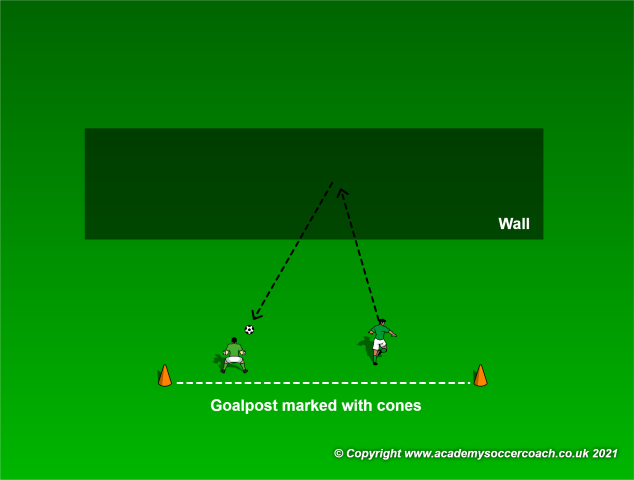
Description: The two goalkeepers aim to score against each other by kicking the ball against the wall and from the rebound it passes between the two cones set as a goalpost. They play continuously by taking shots and making saves.
Variation: More than one goalkeeper takes part. Prior to shooting the goalkeeper taking the shot shouts the name of the goalkeeper who has to make the save. If the latter fails to save the ball and a goal is scored he will be eliminated for that round. Continue playing until only one goalkeeper remains in the game. The maximum number of goalkeepers should not be more than five. This is to ensure that eliminated goalkeepers do not spend too much time waiting. If as an example we have six goalkeepers, we set two simultaneous games with three players in each game rather than six players in one game. This method also makes the game less complex.
Key outcomes:
1. Ready stance.
2. Quick footwork for quick movement to get to the ball.
3. W shape of the hands to catch the ball.
By Philip Cauchi
